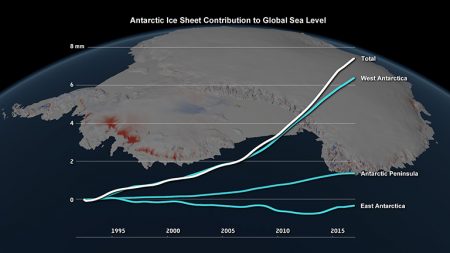June 16, 2018 – At the time of our discussion in a backyard where we were both attending a strawberry tea social, I said to my climate change skeptic friend that validation of global warming doesn’t come from a superficial look at Antarctic climate data. Rather, that studying carbon dioxide (CO2) levels in the atmosphere and correlating the rise to mean global temperature was the key metric. He scoffed at me while pointing to increased sea ice in the Southern Ocean adjacent to Antarctica.
At the time of our discussion, I remembered having written about the correlation between global warming and the growth in Antarctic sea ice in a blog posting some three years earlier.
But it wasn’t my writing that was giving my climate change skeptic friend the fuel for his anti-climate change rant. He told me he had been reading a number of articles with headlines that loudly described the evidence of Antarctic summer sea ice increasing. Some of those articles written by journalists concluded, based on the Antarctic data, that climate change was a hoax.
What he and these writers failed to note was parts of the data set associated with the summer sea increases indicated that both the Antarctic and Arctic were undergoing a dynamic change that was far more complex.
The evidence showed that as Antarctic sea ice increased, Arctic sea ice declined. Similarly, as Antarctic sea ice thickened, Arctic sea ice thinned.
The disproportionate changes between the Antarctic and Arctic didn’t appear in these articles. And these were important facts including that melting Arctic sea ice was setting a pace 25 times faster than that of a freezing Antarctic, and that Antarctic sea ice increases were more than being offset by decreases in land ice on the continent with the latter evaporating and melting three times faster than the gains being made at sea.
So why would sea ice grow in the Antarctic? The melting of land-based glaciers introduced fresh water into the Southern Ocean in significant quantities. Freshwater is lighter and more buoyant than salt water, and it freezes sooner. Hence, sea ice around the continent where little other change was occurring would lead to sea ice increasing.
Since then research on the Antarctic related to climate change has dramatically increased providing us with a much better picture of what actually is happening at the South Pole. The latest research to be released is a compilation of collected data from 24 satellite surveys, 80 scientists, and 42 international research organizations. The period of study is from 1992 to 2017.
What they found can be summarized as follows:
- ice losses from Antarctica over the stated period of time have raised global sea levels 7.6 millimeters (0.3 inches).
- prior to 2012 ice losses from Antarctica equaled 76 billion metric tons annually.
- since 2012 ice losses have increased to 201 billion metric tons annually.
- West Antarctica has seen ice losses grow from 53 to 159 billion metric tons.
- an ice shelf collapse on the Antarctic Peninsula has added 25 billion metric tons to ice loss per the early 2000s.
- East Antarctic has gained 5 billion metric tons of ice annually over the same period of time.
The ice-sheet data collection project, an ongoing effort by NASA and ESA is continuing to monitor changes in the Antarctic. Satellites continue to observe and collect information on the continent’s changing profile. An organization called IMBIE, formed in 2011 intends to provide annual updates to the ice status of the southern continent and its surrounding ocean. The data collection that produced the results described here comes from openly available data sets collected and posted to a spreadsheet which can be downloaded from the IMBIE site.
What lies ahead?
Two possible scenarios projected 50 years into the future:
Without efforts to reduce carbon emissions on a global scale, researchers describe outcomes as follows:
- A loss of major ice shelves by 2070 leading to increased loss of grounded Antarctic ice leading to an accelerated sea level rise.
- The loss of sea ice contributing to dramatic changes in the marine environment in polar regions.
- Expansion of human activity in Antarctica leading to changes in the continental environment and threats to all native existing species.
With efforts to keep emissions low within the parameters called for by the IPCC and Paris Climate Agreement, an alternate outcome is possible including:
- Antarctic ice shelves stabilize and remain intact with a dramatic slowing of annual loss of ice and lower rises in sea levels.
- Antarctic ecosystems remain intact with no mass extinction.
- Human activity in the Antarctic remains managed under a collaborative governance regime to ensure the continent’s native species survive.
The complete study entitled “Mass balance of the Antarctic Ice sheet from 1992 to 2017” appears in the June 13, 2018 edition of the journal Nature.
The infographic and chart below illustrate the contribution that Antarctic ice loss is making to global sea level by showing which geographic areas of the continent are contributing the most. The stability of West Antarctica’s continental ice is clearly of greatest concern.
















